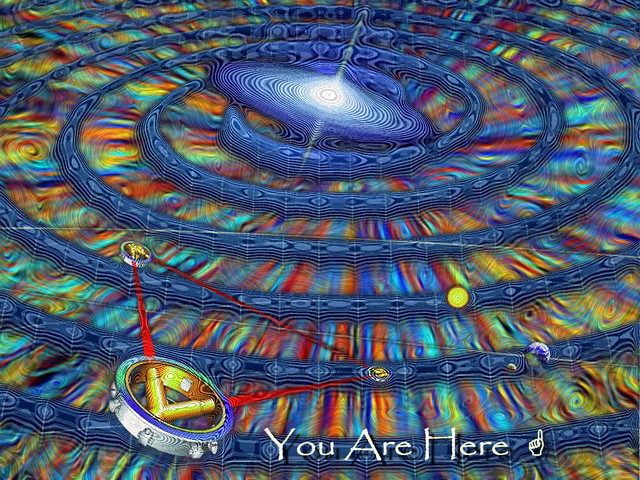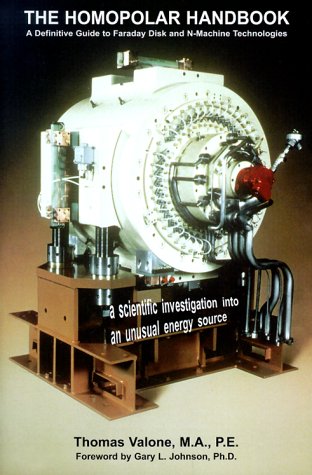Our World May Be a Giant Hologram
by Marcus Chown
DRIVING through the countryside south of Hanover, it would be easy to miss the GEO600experiment. From the outside, it doesn't look much: in the corner of a fieldstands an assortment of boxy temporary buildings, from which two long trenches emerge, at a right angle to each other, covered with corrugated iron. Underneath the metal sheets, however, lies a detector that stretches for 600 metres.
For the past seven years, this German set-up has been looking for gravitational waves - ripples in space-time thrown off by super-dense astronomical objects such as neutron stars and black holes. GEO600 has not detected any gravitational waves so far, but it might inadvertently have made the most important discovery in physics for half a century.
For many months, the GEO600 team-members had been scratching their heads over inexplicable noise that is plaguing their giant detector. Then, out of the blue, a researcher approached them with an explanation. In fact, he had even predicted the noise before he knew they were detecting it. According to Craig Hogan, a physicist at the Fermilab particle physics lab in Batavia, Illinois, GEO600 has stumbled upon the fundamental limit of space-time - the point where space-time stops behaving like the smooth continuum Einstein described and instead dissolves into "grains", just as a newspaper photograph dissolves into dots as you zoom in. "It looks like GEO600 is being buffeted by the microscopic quantum convulsions of space-time," says Hogan.
If this doesn't blow your socks off, then Hogan, who has just been appointeddirector of Fermilab's Center for Particle Astrophysics, has an even bigger shock in store: "If the GEO600 result is what I suspect it is, then we are all living in a giant cosmic hologram."
The idea that we live in a hologram probably sounds absurd, but it is a natural extension of our best understanding of black holes, and something with a pretty firm theoretical footing. It has also been surprisingly helpful for physicists wrestling with theories of how the universe works at its most fundamental level.
The holograms you find on credit cards and banknotes are etched on two-dimensional plastic films. When light bounces off them, it recreates the appearance of a 3D image. In the 1990s physicists Leonard Susskind and Nobel prizewinner Gerard 't Hooft suggested that the same principle might apply to the universe as a whole. Our everyday experience might itself be a holographic projection of physical processes that take place on a distant, 2D surface.
The "holographic principle" challenges our sensibilities. It seems hard to believe that you woke up, brushed your teeth and are reading this article because of something happening on the boundary of the universe. No one knows what it would mean for us if we really do live in a hologram, yet theorists have good reasons to believe that many aspects of the holographic principle are true.
Susskind and Hooft's remarkable idea was motivated by ground-breaking work on black holes by Jacob Bekenstein of the Hebrew University of Jerusalem in Israel and Stephen Hawkingat the University of Cambridge. In the mid-1970s, Hawking showed that black holes are in fact not entirely "black" but instead slowly emit radiation, which causes them to evaporate and eventually disappear. This poses a puzzle, because Hawking radiation does not convey any information about the interior of a black hole. When the black hole has gone, all the information about the star that collapsed to form the black hole has vanished, which contradicts the widely affirmed principle that information cannot be destroyed. This is known as the black hole information paradox.
Bekenstein's work provided an important clue in resolving the paradox. He discovered that a black hole's entropy - which is synonymous with its information content - is proportional to the surface area of its event horizon. This is the theoretical surface that cloaks the black hole and marks the point of no return for infalling matter or light. Theorists have since shown that microscopic quantum ripples at the event horizon can encode the information inside the black hole, so there is no mysterious information loss as the black hole evaporates.
Crucially, this provides a deep physical insight: the 3D information about a precursor star can be completely encoded in the 2D horizon of the subsequent black hole - not unlike the 3D image of an object being encoded in a 2D hologram. Susskind and 't Hooft extended the insight to the universe as a whole on the basis that the cosmos has a horizon too - the boundary from beyond which light has not had time to reach us in the 13.7-billion-year lifespan of the universe.
What's more, work by several string theorists, most notably Juan Maldacenaat the Institute for Advanced Study in Princeton, has confirmed that the idea is on the right track. He showed that the physics inside a hypothetical universe with five dimensions and shaped like a Pringle is the same as the physics taking place on the four-dimensional boundary.
According to Hogan, the holographic principle radically changes our picture of space-time. Theoretical physicists have long believed that quantum effects will cause space-time to convulse wildly on the tiniest scales. At this magnification, the fabric of space-time becomes grainy and is ultimately made of tiny units rather like pixels, but a hundred billion billion times smaller than a proton. This distance is known as the Planck length, a mere 10-35 metres.
The Planck length is far beyond the reach of any conceivable experiment, so nobody dared dream that the graininess of space-time might be discernible.
The Planck length is far beyond the reach of any conceivable experiment, so nobody dared dream that the graininess of space-time might be discernible.
That is, not until Hogan realised that the holographic principle changes everything. If space-time is a grainy hologram, then you can think of the universe as a sphere whose outer surface is papered in Planck length-sized squares, each containing one bit of information. The holographic principle says that the amount of information papering the outside must match the number of bits contained inside the volume of the universe.
Since the volume of the spherical universe is much bigger than its outer surface, how could this be true? Hogan realised that in order to have the same number of bits inside the universe as on the boundary, the world inside must be made up of grains bigger than the Planck length. "Or, to put it another way, a holographic universe is blurry," says Hogan.
This is good news for anyone trying to probe the smallest unit of space-time. "Contrary to all expectations, it brings its microscopic quantum structure within reach of current experiments," says Hogan. So while the Planck length is too small for experiments to detect, the holographic "projection" of that graininess could be much, much larger, at around 10-16 metres.
"If you lived inside a hologram, you could tell by measuring the blurring," he says.
"If you lived inside a hologram, you could tell by measuring the blurring," he says.

When Hogan first realised this, he wondered if any experiment might be able to detect the holographic blurriness of space-time. That's where GEO600 comes in.
Gravitational wave detectors like GEO600 are essentially fantastically sensitive rulers. The idea is that if a gravitational wave passes through GEO600, it will alternately stretch space in one direction and squeeze it in another. To measure this, the GEO600 team fires a single laser through a half-silvered mirror called a beam splitter. This divides the light into two beams, which pass down the instrument's 600-metre perpendicular arms and bounce back again. The returning light beams merge together at the beam splitter and create an interference pattern of light and dark regions where the light waves either cancel out or reinforce each other. Any shift in the position of those regions tells you that the relative lengths of the arms has changed.
"The key thing is that such experiments are sensitive to changes in the length of the rulers that are far smaller than the diameter of a proton," says Hogan.
So would they be able to detect a holographic projection of grainy space-time? Of the five gravitational wave detectors around the world, Hogan realised that the Anglo-German GEO600 experiment ought to be the most sensitive to what he had in mind. He predicted that if the experiment's beam splitter is buffeted by the quantum convulsions of space-time, this will show up in its measurements (Physical Review D, vol 77, p 104031). "This random jitter would cause noise in the laser light signal," says Hogan.
In June he sent his predictionto the GEO600 team. "Incredibly, I discovered that the experiment was picking up unexpected noise," says Hogan. GEO600's principal investigator Karsten Danzmann of the Max Planck Institute for Gravitational Physicsin Potsdam, Germany, and also the University of Hanover, admits that the excess noise, with frequencies of between 300 and 1500 hertz, had been bothering the team for a long time. He replied to Hogan and sent him a plot of the noise. "It looked exactly the same as my prediction," says Hogan. "It was as if the beam splitter had an extra sideways jitter."
Incredibly, the experiment was picking up unexpected noise - as if quantum convulsions were causing an extra sideways jitter. No one - including Hogan - is yet claiming that GEO600 has found evidence that we live in a holographic universe. It is far too soon to say. "There could still be a mundane source of the noise," Hogan admits.
Gravitational-wave detectors are extremely sensitive, so those who operate them have to work harder than most to rule out noise. They have to take into account passing clouds, distant traffic, seismological rumbles and many, many other sources that could mask a real signal. "The daily business of improving the sensitivity of these experiments always throws up some excess noise," says Danzmann. "We work to identify its cause, get rid of it and tackle the next source of excess noise." At present there are no clear candidate sources for the noise GEO600 is experiencing. "In this respect I would consider the present situation unpleasant, but not really worrying."
For a while, the GEO600 team thought the noise Hogan was interested in was caused by fluctuations in temperature across the beam splitter. However, the team worked out that this could account for only one-third of the noise at most.
Danzmann says several planned upgrades should improve the sensitivity of GEO600 and eliminate some possible experimental sources of excess noise. "If the noise remains where it is now after these measures, then we have to think again," he says.
If GEO600 really has discovered holographic noise from quantum convulsions of space-time, then it presents a double-edged sword for gravitational wave researchers. One on hand, the noise will handicap their attempts to detect gravitational waves. On the other, it could represent an even more fundamental discovery.
Such a situation would not be unprecedented in physics. Giant detectors built to look for a hypothetical form of radioactivity in which protons decay never found such a thing. Instead, they discovered that neutrinos can change from one type into another - arguably more important because it could tell us how the universe came to be filled with matter and not antimatter (New Scientist, 12 April 2008, p 26).
It would be ironic if an instrument built to detect something as vast as astrophysical sources of gravitational waves inadvertently detected the minuscule graininess of space-time. "Speaking as a fundamental physicist, I see discovering holographic noise as far more interesting," says Hogan.
Small price to pay
Despite the fact that if Hogan is right, and holographic noise will spoil GEO600's ability to detect gravitational waves, Danzmann is upbeat. "Even if it limits GEO600's sensitivity in some frequency range, it would be a price we would be happy to pay in return for the first detection of the graininess of space-time." he says. "You bet we would be pleased. It would be one of the most remarkable discoveries in a long time."
However Danzmann is cautious about Hogan's proposal and believes more theoretical work needs to be done. "It's intriguing," he says. "But it's not really a theory yet, more just an idea." Like many others, Danzmann agrees it is too early to make any definitive claims. "Let's wait and see," he says. "We think it's at least a year too early to get excited."
The longer the puzzle remains, however, the stronger the motivation becomes to build a dedicated instrument to probe holographic noise. John Cramer of the University of Washington in Seattle agrees. It was a "lucky accident" that Hogan's predictions could be connected to the GEO600 experiment, he says. "It seems clear that much better experimental investigations could be mounted if they were focused specifically on the measurement and characterisation of holographic noise and related phenomena."
One possibility, according to Hogan, would be to use a device called an atom interferometer. These operate using the same principle as laser-based detectors but use beams made of ultracold atoms rather than laser light. Because atoms can behave as waves with a much smaller wavelength than light, atom interferometers are significantly smaller and therefore cheaper to build than their gravitational-wave-detector counterparts.
So what would it mean it if holographic noise has been found? Cramer likens it to the discoveryof unexpected noise by an antenna at Bell Labs in New Jersey in 1964. That noise turned out to be the cosmic microwave background, the afterglow of the big bang fireball. "Not only did it earn Arno Penzias and Robert Wilson a Nobel prize,but it confirmed the big bang and opened up a whole field of cosmology," says Cramer.
Hogan is more specific. "Forget Quantum of Solace, we would have directly observed the quantum of time," says Hogan. "It's the smallest possible interval of time - the Planck length divided by the speed of light."
More importantly, confirming the holographic principle would be a big help to researchers trying to unite quantum mechanics and Einstein's theory of gravity. Today the most popular approach to quantum gravity is string theory, which researchers hope could describe happenings in the universe at the most fundamental level. But it is not the only show in town. "Holographic space-time is used in certain approaches to quantising gravity that have a strong connection to string theory," says Cramer. "Consequently, some quantum gravity theories might be falsified and others reinforced."
Hogan agrees that if the holographic principle is confirmed, it rules out all approaches to quantum gravity that do not incorporate the holographic principle. Conversely, it would be a boost for those that do - including some derived from string theory and something called matrix theory. "Ultimately, we may have our first indication of how space-time emerges out of quantum theory." As serendipitous discoveries go, it's hard to get more ground-breaking than that.
Marcus Chown is the author of Quantum Theory Cannot Hurt You (Faber, 2008)
Source: http://www.newscientist.com/article/mg20126911.300-our-world-may-be-a-giant-hologram.html?full=true
images - http://www.essentia.com/discovery/images/000AF072-4891-1F0A-97AE80A84189EEDF_p64.jpg
http://farm6.static.flickr.com/5030/5615218795_8d7cae658f_b.jpg
http://serpo.openmindsforum.com/r28pics/r28comb.jpg
http://farm6.static.flickr.com/5110/5615801606_bf01c7e7f2_b.jpg
images - http://www.essentia.com/discovery/images/000AF072-4891-1F0A-97AE80A84189EEDF_p64.jpg
http://farm6.static.flickr.com/5030/5615218795_8d7cae658f_b.jpg
http://serpo.openmindsforum.com/r28pics/r28comb.jpg
http://farm6.static.flickr.com/5110/5615801606_bf01c7e7f2_b.jpg
For further enlightening info enter a word or phrase into the search box @ New Illuminati:
@ http://nexusilluminati.blogspot.com (or click on any tag at the bottom of the page for direct references)
The Her(m)etic Hermit - http://hermetic.blog.com
New Illuminati – http://nexusilluminati.blogspot.com
New Illuminati on Facebook - http://www.facebook.com/pages/New-Illuminati/320674219559
This material is published under Creative Commons Copyright (unless an individual item is declared otherwise by copyright holder) – reproduction for non-profit use is permitted & encouraged, if you give attribution to the work & author - and please include a (preferably active) link to the original along with this notice. Feel free to make non-commercial hard (printed) or software copies or mirror sites - you never know how long something will stay glued to the web – but remember attribution! If you like what you see, please send a tiny donation or leave a comment – and thanks for reading this far…
From the New Illuminati – http://nexusilluminati.blogspot.com
















